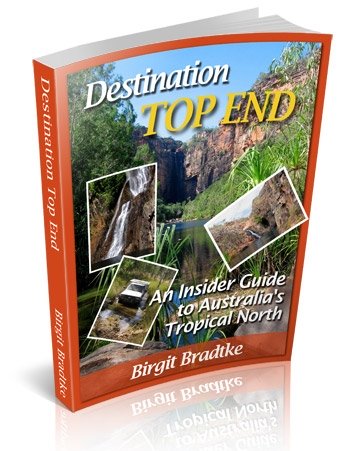Irukandji At Broome Beaches
Learn about Irukandji, the nasties that frequent the oceans in northern Western Australia and the beaches on the Kimberley coast.
When you read about Broome beaches you might have come across warnings about "stingers".
What people usually refer to when they talk about stingers are box jellyfish or Irukandji, very dangerous and sometimes lethal creatures.
There are several kinds of box jellyfish.
Only two of them are dangerous, and both can be found along the beaches of Broome.
What's worse, although the risk is higher during the wet season (swimming is definitely not recommended during the wet season), box jellyfish are actually present near Broome all year round...
The largest kind of box jellyfish at about 30 cm diametre is the multi-tentacled species Chironex Fleckeri, usually just called Australian box jellyfish. This species has been well known for years, and there is a lot of information available.
Not so well known is another, less than thumbnail sized type, with only one tentacle at each corner, called Irukandji. Irukandji was originally used to refer to a single species of jellyfish, Carukia barnesi. Today though that name is used for any species that causes the same symptoms, Irukandji syndrome (see below).
In July 2006 a report by Western Australian Health marine expert Conrad Macrokanis gave details about two newly discovered species of Irukandji. It showed that these previously unknown species have been responsible for more painful stings in Broome than any other jellyfish found in Australian oceans!
Here are some recent numbers:
- 159 Irukandji stings were recorded in Broome over a five year period.
- Three patients developed life threatening complications and had to be airlifted to hospital. (Four days in intensive care for one patient!)
- Many of the victims needed morphine to treat the pain. The average dose used was 20mg, twice of what is normally used on a 100kg man!
- One patient required 300mg over an extended time period! Now that is pain that I can't even begin to imagine.
- 25% of the people stung were hospitalized.
- And interestingly, there were others who took a couple of Panadeine Forte and went home and were just fine.
It appears Irukandji stings are quite a common occurrence on Cable Beach and near Broome in general. The most notable result is excruciating pain. Nobody has died in Broome, but it was very close for three people. (Two fatal Irukandji attacks have been recorded in other parts of northern Australia, in one case the victim had a pre-existing heart condition.)
Though Irukandji stings are also common on the east coast, the rate of jellyfish stings in Broome/northern WA is currently the highest for all of Australia.
So can you swim at all in Broome?
What good are all these Broome beaches if you can't swim?
A lot of work has been done recently trying to determine weather and other factors that all these stings had in common to give recommendations. The results indicate that water temperatures above 28.3C, after midday, and windy days were all common factors in stings. Some sources say so were incoming high tides, others say outgoing high tides. Well, maybe just stay out of the water around high tides altogether...
The water temperature would explain why the risk to get stung is so much higher in Broome during the wet season, even though box jellyfish are present all year round.
Swimming is definitely not recommended in Broome in the wet season, and even for some time after. Stings have happened as late as May and June, it takes a while for the water to cool down.
There are several beaches north of Broome that have never had any problems with stingers, like Middle Lagoon and Cape Leveque. It may be due to their particular location, the reefs, the currents in the oceans, who knows... One thing to keep in mind though is that the fact that nothing ever happened is no guarantee that nothing will ever happen!
In any way it's a good idea to find out what to do if...
Irukandji Syndrome
Unlike the much more dangerous sting of an Australian box jellyfish an Irukandji sting is not necessarily immediately painful (though it may be). Symptoms appear 5 to 45 minutes (on average 30 minutes) after the sting, and include lower back pain, muscle cramps, sweating, nausea, vomiting, restlessness, anxiety and palpitations. In the most severe cases people developed pulmonary oedema (water in the lungs), hypertension and toxic heart failure.
The treatment of the stung area is similar to that used for Australian box jellyfish stings: neutralise the remaining stinging cells with vinegar before removing the tentacles. There is no antivenom for Irukandji syndrome.
The symptoms may disappear within 4 to 30 hours, though in some cases it can take up to a week.
Because of the potential for life threatening complications it is a good idea to take the patient to a hospital as quickly as possible. (The victim will probably be screaming for morphine anyway...) Broome hospital is very experienced with Irukandji symptom and they know exactly what to do.
It is unlikely that a healthy person will die from an Irukandji sting, but most people who got stung say they wished they would while going through the pain. One person said he would rather be stung by Chironex fleckeri "because the pain goes away in 20 minutes or you die". Another woman said, "I didn't think it was possible for anyone to endure that level of pain without turning into a vegetable."
Stay out of the water during jellyfish season.
Also read up on the much more dangerous Australian Box Jellyfish.
And go read some nicer things about Broome :-)
Travelling to the Kimberley?
The FREE Kimberley Pocket Guide
A great introduction to travel in the Kimberley region and along the Gibb. This free resource will answer all the questions you might have in the early stages of planning a trip.
Destination Kimberley
The full Kimberley travel guide shows you how to make the most of your adventure at Australia's last frontier. Destination Kimberley includes the most detailed and most current guide to the Gibb River Road available anywhere. Also called "The Bible" by its readers.
Travelling to the Northern Territory?
Destination Top End offers the same comprehensive, detailed insider information for the tropical regions of the Northern Territory. Be the best informed traveller in the Kakadu, Litchfield and Katherine Gorge national parks and beyond!
A must have if you travel to or from Darwin.
NEW! Destination Red Centre is the latest addition in this popular series. Monica Coleman takes you through Australia's red Outback heart, offering all the detail and insider tips that you have come to know and love about our guides. With special emphasis on Aboriginal communities and culture.
A must have if you travel to or from Alice Springs/Uluru.




